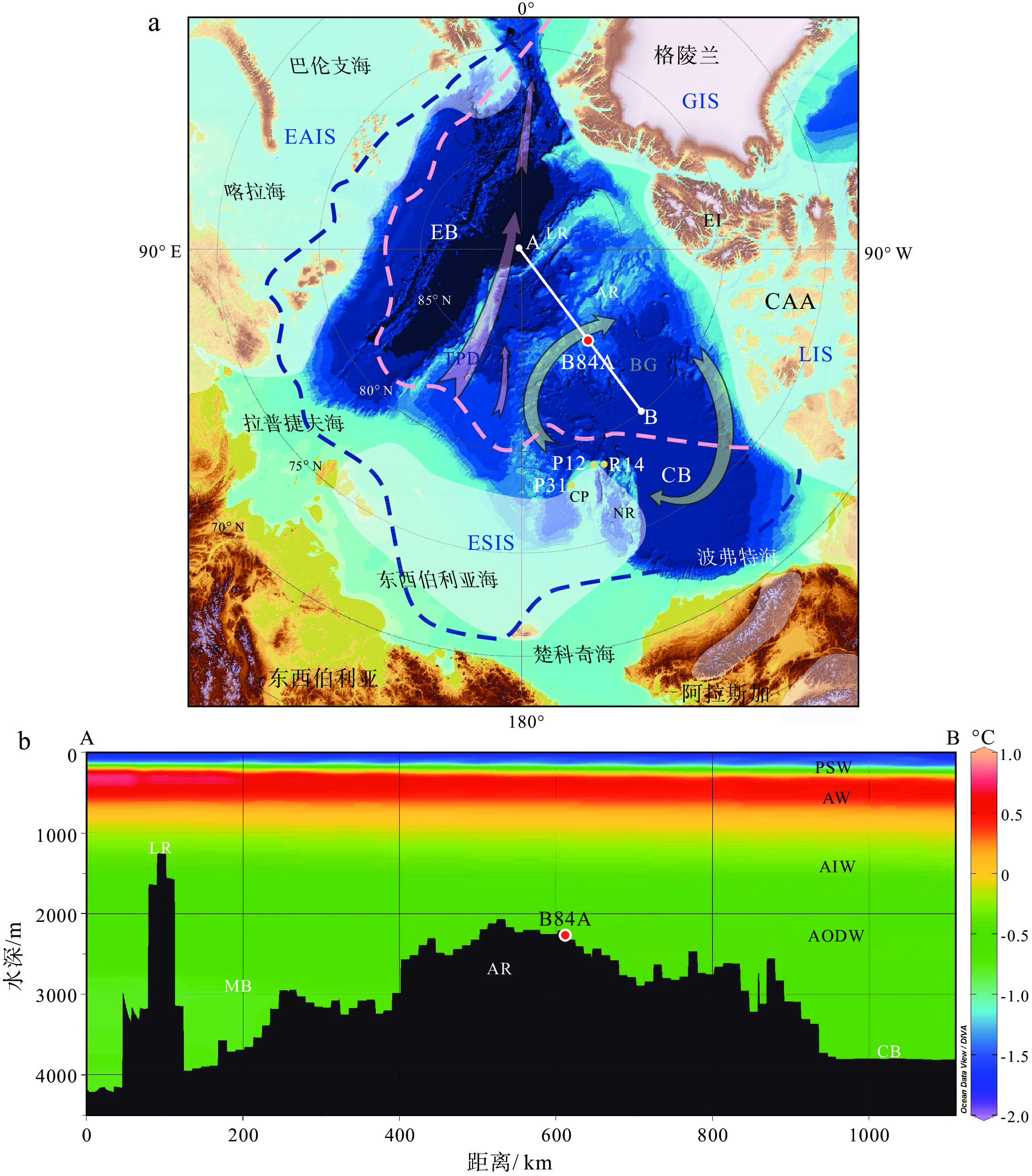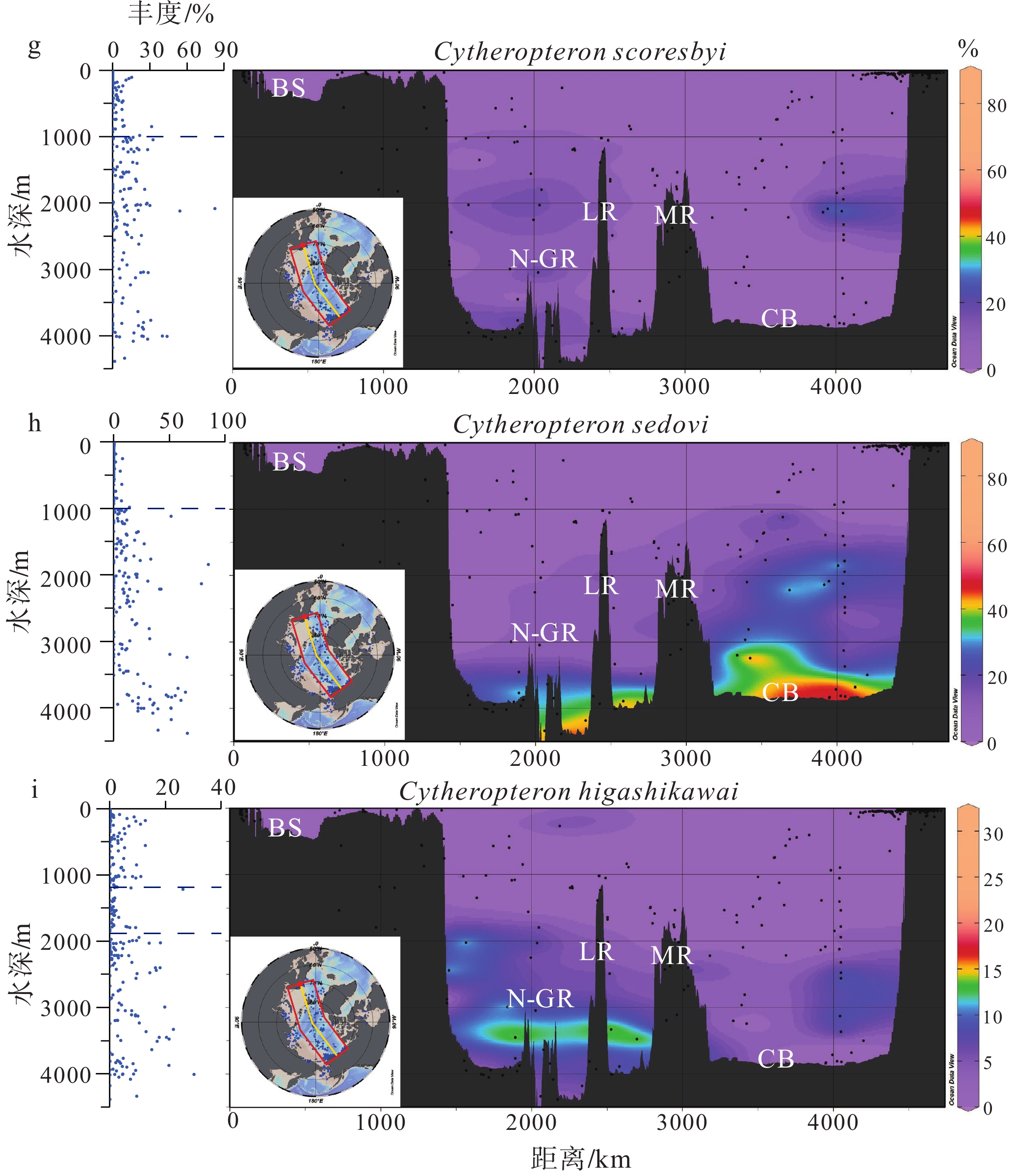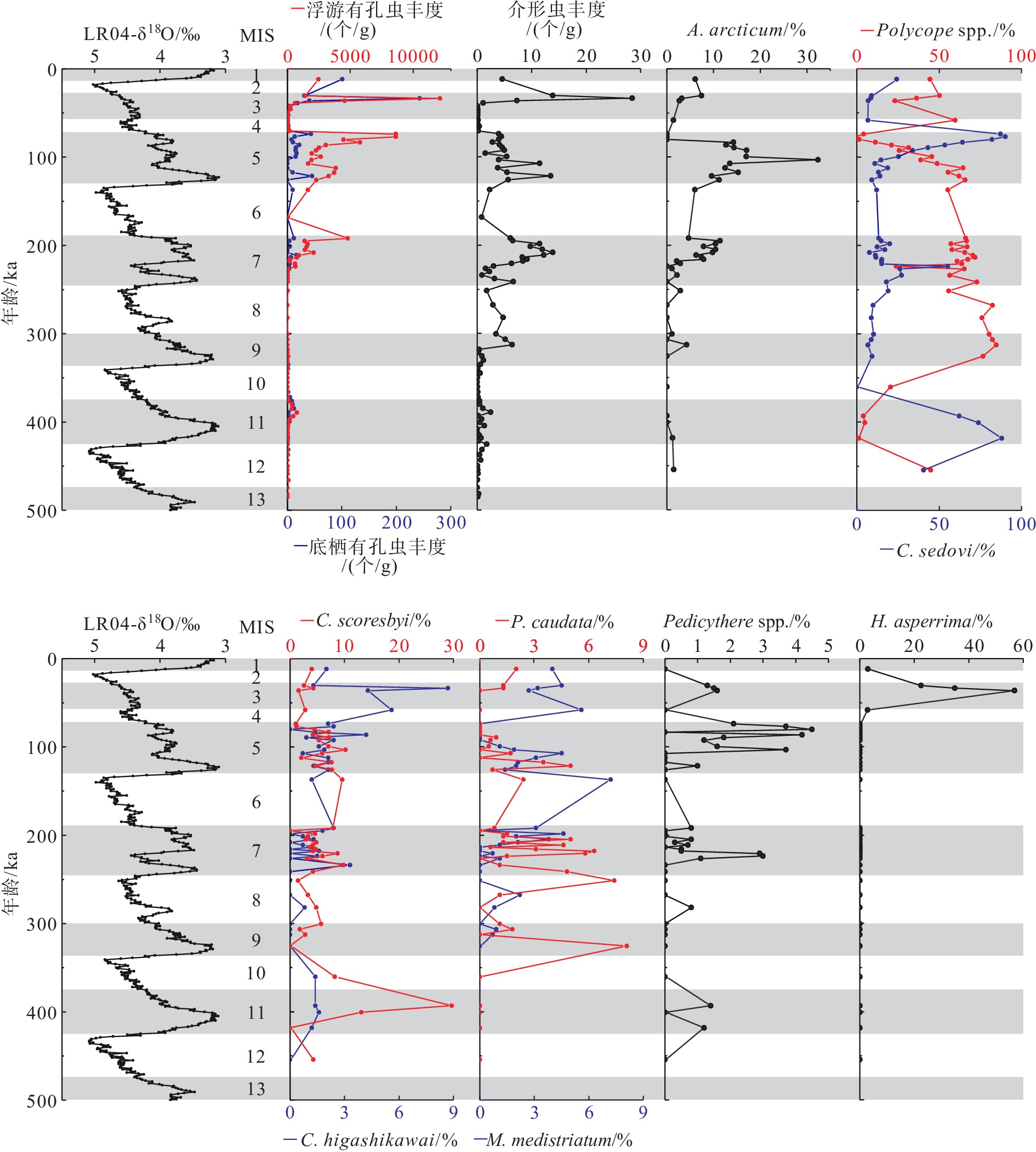Late Quaternary paleoceanographic history of the Alpha Ridge, central Arctic Ocean based on ostracode records
-
摘要:
基于北冰洋中部阿尔法脊ARC3-B84A岩芯(水深2280 m)中的介形虫化石群记录,重建了MIS 13期以来该海域的古海洋环境变迁。从该岩芯获取的介形虫壳瓣逾7000枚,包含8属11种。由介形虫丰度所代表的底栖生物古生产力在MIS 13–10期很低,进入MIS 9期之后显著升高。海冰指示种Acetabulastoma arcticum显示常年海冰很可能是在MIS 9期之后出现的。在所有属种中,北冰洋中层水(AIW)指示种Polycope spp.和北冰洋深层水(AODW)指示种Cytheropteron sedovi的个体数量最多,二者在岩芯中的百分含量呈负相关,它们与其他属种(Microcythere medistriatum, Pseudocythere caudata, Pedicythere spp., Cytheropteron scoresbyi, Cytheropteron higashikawai, Henryhowella asperrima)一起,揭示该岩芯站位经历了如下的水团变迁历史:最初处于AODW上部(MIS 13–12),之后被上涌的AODW下部所取代(MIS 11–10);尔后,上方的AIW大幅下潜,取代了AODW(MIS 9期–MIS 5早期);在MIS 5中–晚期,AODW下部快速上涌,取代了AIW;最终在MIS 4之后,水团定格在AODW上部。
Abstract:The paleoceanographic history of the central Arctic Ocean since Marine Isotope Stage (MIS) 13 was reconstructed based on ostracode assemblages in a gravity core from the Alpha Ridge (modern water depth 2280 m). Over 7000 ostracode valves, including 8 genera and 11 species, were obtained from the core. The biological productivity, as represented by ostracode abundance, is low during MIS 13-10 but is markedly high throughout MIS 9-1. The distribution of Acetabulastoma arcticum, a sea ice-dwelling species, indicates that perennial sea ice was probably absent during MIS 13-9. The ostracode assemblages are predominated by Polycope spp. (an indicator of Arctic Intermediate Water, AIW) and Cytheropteron sedovi (an indicator of Arctic Ocean Deep Water, AODW), and are accompanied by Microcythere medistriatum, Pseudocythere caudata, Pedicythere spp., Cytheropteron scoresbyi, Cytheropteron higashikawai, and Henryhowella asperrima. The relative frequencies (%) of Polycope spp. and Cytheropteron sedovi show inverse correlation throughout the core. The reconstructed paleo-watermass history is as follows: initially, the core site was occupied by the upper part of AODW (MIS 13-12) and lower part of AODW (MIS 11-10); after then, the overlying AIW shifted downward and took the place of AODW (MIS 9-early MIS 5); later, the lower part of AODW shifted up rapidly (middle to late MIS 5) and finally the upper part of AODW came to settle down at the site (MIS 4-1).
-
Key words:
- ostracode /
- paleoceanographic history /
- central Arctic Ocean /
- Alpha Ridge /
- Late Quaternary
-

-
表 1 本研究使用的岩芯及其信息汇总
Table 1. Information for all the cores used in this study
表 2 B84A岩芯中的介形虫优势种和常见种在现代北冰洋各水团中的百分含量
Table 2. Relative frequencies (%) of ostracode taxa, which are abundant or common in core B84A, in the Arctic water masses
种名 0~50 m
(PSW)50~200 m
(盐跃层)200~1000 m
(AW)1000~2 000 m
(AIW)>2 000 m
(AODW)Polycope spp. 0.38 1.47 8.44 32.67 6.82 Microcythere medistriatum 0 0 0.20 2.07 1.92 Pseudocythere caudata 0.03 0.35 1.39 2.78 1.67 Pedicythere spp. 0 0.05 0.21 1.12 0.64 Henryhowella asperrima 0 0 0 1.42 2.90 Cytheropteron scoresbyi 0 0.39 3.64 8.05 10.47 Cytheropteron sedovi 0 0.02 1.11 9.72 19.16 Cytheropteron higashikawai 0 0.42 2.31 2.97 5.80 表 3 B84A岩芯中介形虫主要属种指示的水团及其在各时代的百分含量
Table 3. Correspondence of ostracode taxa with water masses, and their relative frequencies (%) in different times as recorded in core B84A
种名 对应的水团 MIS 13–12 MIS 11–10 MIS 9–6 MIS 5 MIS 4–1 Polycope spp. AIW 44.9 7.7 66.4 34.1 42.8 Cytheropteron sedovi AODW下部 40.6 71.7 15.9 40.1 11.4 Microcythere medistriatum AIW&AODW 0 0 1.3 1.1 4.0 Pseudocythere caudata AIW 0 0 2.6 0.9 0.9 Pedicythere spp. AIW 0 0.5 0.5 1.7 0.9 Henryhowella asperrima AODW上部 0 0 0 0 24.0 Cytheropteron scoresbyi AODW&AIW 4.3 12.8 4.4 5.4 3.1 Cytheropteron higashikawai AODW下部 0 1.4 0.7 1.8 4.4 -
[1] Rudels B. Arctic Ocean circulation, processes and water masses: a description of observations and ideas with focus on the period prior to the International Polar Year 2007–2009 [J]. Progress in Oceanography, 2015, 132: 22-67. doi: 10.1016/j.pocean.2013.11.006
[2] Aagaard K, Carmack E C. The role of sea ice and other fresh water in the Arctic circulation [J]. Journal of Geophysical Research:Oceans, 1989, 94(C10): 14485-14498. doi: 10.1029/JC094iC10p14485
[3] Anderson L G, Björk G, Holby O, et al. Water masses and circulation in the Eurasian Basin: results from the Oden 91 expedition [J]. Journal of Geophysical Research, 1994, 99(C2): 3273-3283. doi: 10.1029/93JC02977
[4] Jones E P. Circulation in the Arctic Ocean [J]. Polar Research, 2001, 20(2): 139-146. doi: 10.1111/j.1751-8369.2001.tb00049.x
[5] Rudels B, Jones E P, Schauer U, et al. Atlantic sources of the Arctic Ocean surface and halocline waters [J]. Polar Research:Oceans, 2004, 23(2): 181-208. doi: 10.1111/j.1751-8369.2004.tb00007.x
[6] Rudels B, Anderson L G, Jones E P. Formation and evolution of the surface mixed layer and halocline of the Arctic Ocean [J]. Journal of Geophysical Research:Oceans, 1996, 101(C4): 8807-8821. doi: 10.1029/96JC00143
[7] Beszczynska-Möller A, Woodgate R A, Lee C M, et al. A synthesis of exchanges through the main oceanic gateways to the Arctic Ocean [J]. Oceanography, 2011, 24(3): 82-99. doi: 10.5670/oceanog.2011.59
[8] Steele M, Boyd T. Retreat of the cold halocline layer in the Arctic Ocean [J]. Journal of Geophysical Research:Oceans, 1998, 103(C5): 10419-10435. doi: 10.1029/98JC00580
[9] Holmes R M, McClelland J W, Peterson B J, et al. A circumpolar perspective on fluvial sediment flux to the Arctic Ocean [J]. Global Biogeochemical Cycles, 2002, 16(4): 1098. doi: 10.1029/2001GB001849
[10] Aagaard K, Coachman L K, Carmack E. On the halocline of the Arctic Ocean [J]. Deep-Sea Research Part A. Oceanographic Research Papers, 1981, 28(6): 529-545. doi: 10.1016/0198-0149(81)90115-1
[11] Giles K A, Laxon S W, Ridout A L, et al. Western Arctic Ocean freshwater storage increased by wind-driven spin-up of the Beaufort Gyre [J]. Nature Geoscience, 2012, 5(3): 194-197. doi: 10.1038/ngeo1379
[12] Proshutinsky A, Krishfield R, Toole J M, et al. Analysis of the Beaufort Gyre freshwater content in 2003–2018 [J]. Journal of Geophysical Research Oceans, 2019, 124(12): 9658-9689. doi: 10.1029/2019JC015281
[13] Comiso J C. Large-scale characteristics and variability of the global sea ice cover [M]. //Thomas D N, Dieckmann G S. Sea Ice: An Introduction to Its Physics, Chemistry, Biology and Geology. Chapter 4. Oxford: Wiley-Blackwell, 2003: 112–141.
[14] Haley B A, Frank M, Spielhagen R F, et al. Influence of brine formation on Arctic Ocean circulation over the past 15 million years [J]. Nature Geoscience, 2008, 1: 68-72. doi: 10.1038/ngeo.2007.5
[15] Cronin T M, Dwyer G S, Farmer J, et al. Deep Arctic Ocean warming during the last glacial cycle [J]. Nature Geoscience, 2012, 5: 631-634. doi: 10.1038/ngeo1557
[16] Gemery L, Cronin T M, Briggs Jr W M, et al. An Arctic and Subarctic ostracode database: biogeographic and paleoceanographic applications [J]. Hydrobiologia, 2015, https://doi.org/10.1007/s10750-015-2587-4.
[17] Zhou B C, Wang R J, Xiao W S, et al. Late Quaternary paleoceanographic history based on ostracode records from the Chukchi Plateau, western Arctic Ocean [J]. Marine Micropaleontology, 2021, 165: 101987. doi: 10.1016/j.marmicro.2021.101987
[18] Poirier R K, Cronin T M, Briggs Jr W M, et al. Central Arctic paleoceanography for the last 50 kyr based on ostracode faunal assemblages [J]. Marine Micropaleontology, 2012, 88–89: 65–76.
[19] Gemery L, Cronin T M, Poirier R K, et al. Central Arctic Ocean paleoceanography from ~50 ka to present, on the basis of ostracode faunal assemblages from the SWERUS 2014 expedition [J]. Climate of the Past, 2017, 13(11): 1473-1489. doi: 10.5194/cp-13-1473-2017
[20] 周保春, 王汝建, 梅静. 末次冰消期后大西洋水进入楚科奇海台: 来自介形虫化石群的证据[J]. 海洋地质与第四纪地质, 2015, 35(3):73-82
ZHOU Baochun, WANG Rujian, MEI Jing. The spreading of Atlantic Water onto Chukchi Plateau after Last Deglaciation: evidence from fossil ostracods [J]. Marine Geology & Quaternary Geology, 2015, 35(3): 73-82.
[21] 张海生. 中国第三次北极科学考察报告[M]. 北京: 海洋出版社, 2009.
ZHANG Haisheng. The Report of 2008 Chinese Arctic Research Expedition [M]. Beijing: China Ocean Press, 2009.
[22] Parkinson C L, Cavalieri D J. Arctic sea ice variability and trends, 1979–2006 [J]. Journal of Geophysical Research, 2008, 113: C07003. doi: 10.1029/2007JC004558
[23] Niessen F, Hong J K, Hegewald A, et al. Repeated Pleistocene glaciation of the east Siberian continental margin [J]. Nature Geoscience, 2013, 6: 842-846. doi: 10.1038/ngeo1904
[24] Jakobsson M, Nilsson J, Anderson L, et al. Evidence for an ice shelf covering the central Arctic Ocean during the penultimate glaciation [J]. Nature Communications, 2016, 7: 10365. doi: 10.1038/ncomms10365
[25] Yasuhara M, Stepanova A, Okahashi H, et al. Taxonomic revision of deep-sea Ostracoda from the Arctic Ocean [J]. Micropaleontology, 2014, 60(5): 399-444.
[26] Schlitzer R. Ocean Data View [EB/OL]. (2022-03-04). http://odv.awi.de.
[27] Wang R J, Polyak L, Xiao W S, et al. Late-Middle Quaternary lithostratigraphy and sedimentation patterns on the Alpha Ridge, central Arctic Ocean: Implications for Arctic climate variability on orbital time scales [J]. Quaternary Science Reviews, 2018, 181: 93-108. doi: 10.1016/j.quascirev.2017.12.006
[28] Lisiecki E, Raymo E. A Pliocene-Pleistocene stack of 57 globally distributed benthic δ 18O records [J]. Paleoceanography, 2005, 20: PA1003. doi: 10.1029/2004PA001071
[29] Cronin T M, Holtz Jr T R, Stein R, et al. Late Quaternary paleoceanography of the Eurasian Basin, Arctic Ocean [J]. Paleoceanography, 1995, 10(2): 259-281. doi: 10.1029/94PA03149
[30] Cronin T M, Polyak L, Reed D, et al. A 600-ka Arctic sea-ice record from Mendeleev Ridge based on ostracodes [J]. Quaternary Science Reviews, 2013, 79: 157-167. doi: 10.1016/j.quascirev.2012.12.010
[31] Joy J A, Clark D L. The distribution, ecology and systematics of the benthic Ostracoda of the central Arctic Ocean [J]. Micropaleontology, 1977, 23(2): 129-154. doi: 10.2307/1485329
[32] Jones R Ll, Whatley R C, Cronin T M, et al. Reconstructing late Quaternary deep-water masses in the Eastern Arctic Ocean using benthonic Ostracoda [J]. Marine Micropaleontology, 1999, 37: 251-272. doi: 10.1016/S0377-8398(99)00022-5
[33] Sars G O. Oversigt af Norges marine Ostracoder [J]. Forhandlinger I Videnskabs-Selskabet I Christiania, 1866, 1865(1): 1-130.
[34] Cronin T M, DeNinno L H, Polyak L, et al. Quaternary ostracode and foraminiferal biostratigraphy and paleoceanography in the western Arctic Ocean [J]. Marine Micropaleontology, 2014, 111: 118-133. doi: 10.1016/j.marmicro.2014.05.001
[35] Cronin T M, Gemery L, Briggs Jr W M, et al. Quaternary sea-ice history in the Arctic Ocean based on a new ostracode sea-ice proxy [J]. Quaternary Science Reviews, 2010, 29(25-26): 3415-3429. doi: 10.1016/j.quascirev.2010.05.024
[36] Polyak L, Curry W B, Darby D A, et al. Contrasting glacial/interglacial regimes in the western Arctic Ocean as exemplified by a sedimentary record from the Mendeleev Ridge [J]. Palaeogeography, Palaeoclimatology, Palaeoecology, 2004, 203(1-2): 73-93. doi: 10.1016/S0031-0182(03)00661-8
[37] Spielhagen R F, Baumann K H, Erlenkeuser H, et al. Arctic Ocean deep-sea record of northern Eurasian ice sheet history [J]. Quaternary Science Reviews, 2004, 23: 1455-1483. doi: 10.1016/j.quascirev.2003.12.015
[38] Adler R E, Polyak L, Crawford K A, et al. Sediment record from the western Arctic Ocean with an improved Late Quaternary age resolution: HOTRAX core HLY0503-8JPC, Mendeleev Ridge [J]. Global and Planetary Change, 2009, 68: 18-29. doi: 10.1016/j.gloplacha.2009.03.026
-




 下载:
下载:



